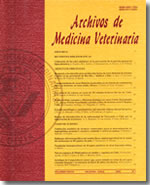Animal welfare indicators during the stunning of bovines slaughtered in federal inspection type slaughterhouses located in northwestern Mexico
Main Article Content
Abstract
To evaluate animal welfare indicators during stunning of bovines slaughtered in three federal inspection type slaughterhouses (A, B and C) six random visits were done, so each plant was visited twice. The stunning method was evaluated using two types of indicators, the first set was registered immediately after stunning, and the second set were measured on the severed head and considered the precision of the shot. A frequency analysis showed that 12.3% of the animals in abattoir A vocalized while the percentage in abattoir B was 31.3%. Corneal reflex average in the abattoirs was lower than 3%; rhythmic breathing was not seen in more than 2.2% of the cattle and between 21.1 and 34.7% of them attempted to raise the head after stunning. In abattoirs A (99.1%), B (97.9%) and C (96.7%) of the bovines were stunned with just one shot. It was found that in 91.1% of the cases in abattoir A the shot was inside a radius of 2 cm, while in abattoirs B and C the percentages were 62.8 and 70.4%. In abattoir A in 41.6% of the cases the time between stunning and exsanguination was less than a minute while in abattoirs B and C the percentages were 0.9 and 27.8. It is concluded that animal welfare indicators show shortcomings compared to international standards negatively affect and induce a high risk to the cattle welfare in the pre-mortem procedures in the stunning box and during bleeding.

